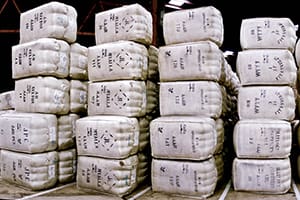 AUSTRALIAN wool prices fell further at auctions this week, with carding types most affected and reducing by 150-250c/kg, as demand adjusted to recent price levels, exchange rates, type availability and pipeline stocks.
AUSTRALIAN wool prices fell further at auctions this week, with carding types most affected and reducing by 150-250c/kg, as demand adjusted to recent price levels, exchange rates, type availability and pipeline stocks.
Although the correction led to the benchmark AWEX Eastern Market Indicator falling 57 cents to 1744c/kg clean — its largest weekly fall since June 2015 — Merino fleece wool under 18 micron made gains of 8-14 cents.
Brokers passed in 14.3 percent of the 42,525 bales offered, and with the $A at US80.28 cents, the EMI in $US terms fell 34 cents to US1400c/kg clean.
AWEX senior market analyst Lionel Plunkett said buyers were again more selective with their purchases and wools with unfavourable test results struggled to find support in the falling market.
“Lots with very high mid-breaks became almost unquotable as they lost buyer interest.
“Conversely, wools with very low mid-breaks attracted intense competition, the result was that some recorded very little change in price.”
Mr Plunkett said 18-20 micron clips were the hardest hit, with prices were generally reduced by 30-80 cents.
“Worth noting is that a stylish selection of 17 micron and finer resisted the falling market and managed increases of 5 to 15 cents.”
Mr Plunkett said in the skirting sector, the higher the vegetable matter content the greater the reduction in price.
The crossbred sector also suffered large corrections, he said.
“Any lines that were poorly prepared lacked buyer interest and suffered heavy discounts.
“Prices generally fell by 40 to 80 cents, the exception being 32 micron and coarser which were only 10 to 20 cents easier.”
Mr Plunkett said the oddment market was the fastest climbing sector over the past three months.
“Many pundits believed that the sector was over-priced and last week saw a significant correction.
“That said, nothing could have prepared the trade for the free fall in prices of this sale.”
Mr Plunkett said carding prices generally fell 150-250 cents.
“The three Merino Carding Indicators fell by an average of 198 cents, and it was the largest weekly fall in cents in the AWEX Carding Indicator for all regions since 1997.
Volatility hard to manage by brokers
Rodwells wool manager Michael de Kleuver said despite the “incredible” 142-cent carding indicator fall on Wednesday after falls totalling about 140 cents in the past week, it is still 100 cents higher than at the same time last year. However, the severity of the price falls was difficult to manage by brokers.
Mr de Kleuver said there is still genuine demand for wool, but the market “has been absolutely red-hot and hitting extreme records” and when it stops rising “people just stop and see where it lands.”
“Don’t forget we are coming off an extremely high base.”
The offering also needed to be considered, he said, with a lot of wool catalogued between 18-19 micron, with not much finer than 17 micron or 22 microns-plus with solid demand.
“Anywhere there was not a lot of wool on offer — ultrafine and superfine wools, medium wools – didn’t go too badly at all.
“I think the volatility will become part and parcel of what we see as things go forward.”
Overseas buyers have 4-6 week inventory buffer
Australian Wool innovation’s weekly market report said while a retracting market is never good news for wool growers, when placed in context, the EMI when expressed in $A is sitting at levels 23.5pc higher than at this time 12 months ago, and more significantly, the demand-indicating $US price for the EMI is a compelling 31.5pc higher than at this time last year.
AWI said general thoughts from the trade pre-sale were rather negative apart from the Merino fleece sector.
“More important was the general consensus post-sale that whilst prices eased off 35c/kg clean on better types across most of the Merino types, the fundamentals within that trade area have not changed.
“Demand has simply not turned off, but price to match demand is just being allowed to adjust to more useable levels.”
AWI said generally good market conditions and solid demand continues for quality worsted length Merino wools, particularly at the finest end — less than 18 micron — of the Merino micron spectrum.
“What has changed though is the urgency for purchases has been somewhat alleviated by the past few weeks buying.
“Overseas users now seem to have a 4 to 6 week buffer of inventory built up so further purchases do not need to be concluded immediately.”
AWI said local buyers here in Australia are not willing, or indeed do not have the funds, to take on stock at the perceived “high” levels in anticipation of that fresh business occurring, so they are prepared to let the market drift for the time being to find that sweet price spot that manufacturers seek.
AWI said the carding wools are coming off enormous record levels, so the price adjustment was said to be coming, but the downturn surprised all by the magnitude of the losses and the velocity of the movement within just one week of selling.
“As several buyers of these wools commented that perhaps the “just ripping off the band aid solution” may be the stimulus to get this sector back to tradeable levels whereby carding product at the retail end can be moved to consumers at acceptable levels.”
AWI said many traders still maintain the downturn in Merino prices to be a brief respite to the ruling strong price trends.
“Drought conditions both here and in South Africa continue to be dangerous for upcoming supply numbers, which most buyers are fully aware of.”
Sources: AWI, AWEX, Rodwells.

HAVE YOUR SAY